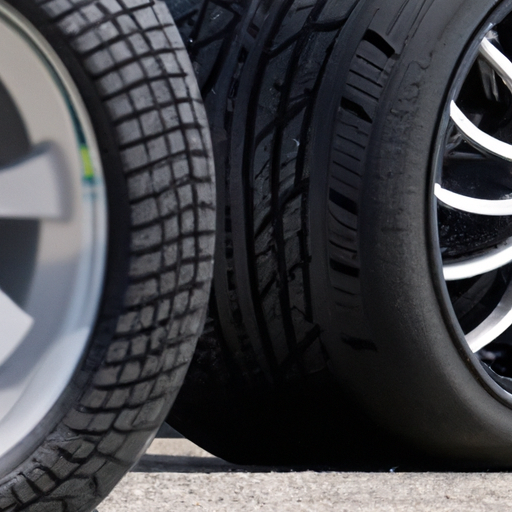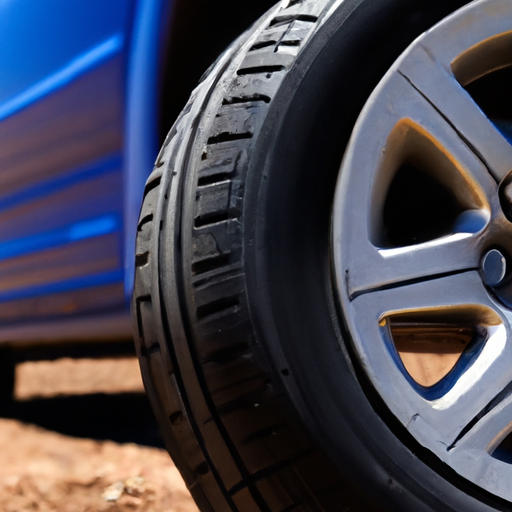When it comes to selecting summer tires for your vehicle, there are a few key factors that you need to consider. From performance and traction to durability and tread life, finding the right summer tires can make a significant difference in your driving experience. Whether you’re planning on hitting the open road for a summer road trip or simply want to enhance your vehicle’s performance during warmer months, understanding these factors will help you make an informed decision. So, let’s take a closer look at what you should consider when selecting summer tires.

1. Tire Size
Finding the Correct Size
When selecting summer tires, one of the first factors to consider is the correct tire size for your vehicle. To find the correct size, you can refer to your vehicle’s owner’s manual or the sidewall of your current tires. The tire size includes three important measurements: width, aspect ratio, and rim diameter. These measurements are usually represented in a format such as 215/55R17.
Determining the Correct Width
The first number in the tire size represents the width of the tire in millimeters. It is essential to choose a summer tire with the correct width to ensure optimal performance and safety. Using a tire that is too narrow may result in reduced grip and handling, while a tire that is too wide can negatively impact fuel efficiency.
Checking the Aspect Ratio
The aspect ratio, represented by the second number in the tire size, compares the tire’s height to its width. It is expressed as a percentage. A lower aspect ratio indicates a lower profile tire with shorter sidewalls, which can offer improved handling and cornering stability. However, it is important to strike a balance between performance and ride comfort when considering the aspect ratio.
Verifying the Correct Rim Diameter
The final number in the tire size represents the diameter of the rim, measured in inches. It is crucial to select a summer tire with the correct rim diameter to ensure a proper fit on your vehicle’s wheels. Using a tire with an incorrect rim diameter can lead to tire damage or compromise the vehicle’s handling and safety.
2. Tire Type
Understanding the Difference between Summer Tires and All-Season Tires
When choosing summer tires, it is important to understand the difference between summer tires and all-season tires. Summer tires are specifically designed for warm weather conditions, offering superior dry and wet traction, as well as enhanced handling and cornering capabilities. All-season tires, on the other hand, are designed to provide reliable performance in a variety of weather conditions, including light snow and rain.
Considering the Performance of Summer Tires
Summer tires excel in dry and hot conditions, providing excellent grip and responsiveness on dry pavement. They are engineered with a tread pattern and compound optimized for warm weather performance. Summer tires offer precise steering response, allowing for more control and precise handling, essential for spirited driving or performance-oriented vehicles.
Evaluating the Performance of All-Season Tires
While all-season tires may offer a compromise in performance compared to summer tires, they provide a convenient option for those who prefer not to switch tires seasonally. All-season tires offer good traction in various conditions, including light snow and rain, making them suitable for areas with mild winters. However, if you live in an area with severe winter conditions, it is advisable to consider dedicated winter tires for optimal safety and performance.
3. Tread Pattern
Identifying the Optimal Tread Pattern
The tread pattern of a summer tire plays a significant role in its performance and safety. Summer tires feature a tread pattern designed to enhance dry and wet traction, as well as to optimize handling characteristics. Look for a tread pattern that includes generous amounts of lateral and circumferential grooves to assist with water evacuation and reduce the risk of hydroplaning. Additionally, tread patterns with solid shoulder blocks can enhance the tire’s grip during cornering and provide stability.
Considering Hydroplaning Resistance
Hydroplaning, the loss of traction due to water buildup between the tire and the road surface, can be a significant safety concern during summer rainstorms. A summer tire with a tread pattern that effectively channels water away from the tire’s contact patch can significantly reduce the risk of hydroplaning. Look for grooves and channels that efficiently move water out from under the tire, allowing for better traction and control on wet roads.
Examining Tread Blocks and Channels
When evaluating tread patterns, pay attention to the size and shape of the tread blocks. Large, solid tread blocks provide more contact area with the road, promoting better dry traction and stability. On the other hand, smaller tread blocks with more channels and sipes can enhance wet traction by dispersing water more effectively. Finding a tread pattern that strikes a balance between dry and wet performance is essential in selecting the right summer tire.
4. Tread Compound
Understanding the Importance of Tread Compound
The tread compound of a summer tire is another crucial factor to consider when making your selection. The tread compound directly affects the tire’s grip, handling, and overall performance in various conditions. Summer tires are typically made from a softer tread compound than all-season or winter tires. This softer compound helps to enhance dry traction and provide better grip on hot pavement.
Evaluating Tread Compound Hardness
The hardness of a tire’s tread compound is measured using a scale known as the durometer. Summer tires generally have a lower durometer rating, indicating a softer tread compound. Softer compounds allow the tire to conform to the road surface, maximizing grip. However, it is important to find a balance, as excessively soft compounds can result in faster tread wear and reduced longevity.
Considering the Benefits of Silica-Based Tread Compounds
Many modern summer tires utilize silica-based tread compounds. Silica helps improve the tire’s wet traction capabilities and provides versatility in a range of temperature conditions. Silica-based compounds maintain their grip on wet surfaces and can offer improved handling in both dry and wet conditions. Additionally, silica-based compounds tend to have lower rolling resistance, which can contribute to better fuel efficiency.

5. Traction
Evaluating Dry Traction Performance
Dry traction is a critical performance characteristic to consider when selecting summer tires. Summer tires are designed to provide exceptional grip and traction on dry pavement, allowing for more precise handling and quicker acceleration. Look for summer tires with a tread pattern and compound specifically formulated to maximize dry traction. Attention to tread design, contact patch characteristics, and compound formulation can greatly influence a tire’s dry traction performance.
Considering Wet Traction Performance
While summer tires excel in dry conditions, they should also provide excellent wet traction to ensure safety during rain showers. The tread pattern and compound of a summer tire play a significant role in its ability to evacuate water and maintain traction on wet surfaces. Look for summer tires with wide circumferential and directional grooves, along with silica-based compounds, to enhance wet traction performance. A tire’s ability to effectively disperse water and maintain contact with the road can greatly reduce the risk of hydroplaning and improve overall wet handling.
Assessing Cornering Grip
Cornering grip refers to a tire’s ability to maintain traction and grip during turns or maneuvers. Summer tires are designed to offer enhanced cornering grip, allowing for confident and predictable handling. Look for summer tires with features such as solid shoulder blocks and unique tread patterns that provide ample contact area and maximize grip when taking corners. A tire with excellent cornering grip can greatly enhance the overall driving experience and ensure safety during spirited driving or emergency maneuvers.
6. Noise Level
Considering Noise Reduction
Noise level is an important consideration when selecting summer tires, especially for those who prioritize a quiet and comfortable driving experience. Some tread patterns and tire designs can generate more road noise than others. Look for summer tires that prioritize noise reduction through the use of advanced tread patterns and technologies. Quieter tires can enhance your overall driving enjoyment and reduce fatigue during long journeys.
Evaluating Different Tread Patterns for Noise Levels
Tread pattern design plays a significant role in a tire’s noise levels. Tires with large, solid tread blocks may generate more noise, especially on rough road surfaces. Conversely, tires with smaller and more intricate tread patterns, including those with multiple sipes and channels, can help reduce road noise by effectively dispersing sound vibrations. When selecting a summer tire, consider your preference for a quiet ride and choose a tread pattern that balances noise reduction with performance characteristics.

7. Ride Comfort
Considering Comfortable Air Pressure Levels
Ride comfort is an important factor to consider, as it can greatly impact your driving experience. Maintaining the proper air pressure in your tires is crucial for optimal ride comfort. Consult your vehicle’s manual or tire manufacturer’s guidance to determine the recommended air pressure for your summer tires. Ensuring that your tires are properly inflated not only improves ride comfort but also contributes to better fuel efficiency and tire longevity.
Evaluating the Role of Sidewall Construction
The sidewall construction of a summer tire can significantly affect ride comfort. Tires with softer sidewalls generally offer a more comfortable riding experience compared to tires with stiffer sidewalls. Softer sidewalls can absorb road imperfections and vibrations, resulting in a smoother ride. However, it is essential to strike a balance, as excessively soft sidewalls may compromise handling and responsiveness. Consider your priorities for ride comfort and handling characteristics when selecting a summer tire.
Assessing Shock Absorption Capabilities
The shock absorption capabilities of a summer tire also contribute to overall ride comfort. Tires with advanced shock absorption technologies and features, such as specialized rubber compounds and innovative tread designs, can help cushion bumps and irregularities in the road surface. When evaluating summer tire options, consider the tire’s ability to effectively absorb shocks and impacts, as a tire that provides a smoother ride can greatly enhance driving comfort.
8. Temperature Range
Understanding the Optimal Temperature Range for Summer Tires
Summer tires are specifically designed for warm weather conditions and perform optimally in higher temperatures. It is important to consider the optimal temperature range for summer tires to ensure their safety and longevity. Using summer tires in colder temperatures or winter conditions can compromise their performance and pose safety risks. Therefore, it is advisable to switch to winter tires when the temperature drops below a certain threshold, usually around 45°F (7°C).
Considering the Performance at High Temperatures
Summer tires are engineered to provide excellent performance in high temperatures. The tread compound of summer tires is formulated to offer maximum grip and traction on hot pavement. The design and construction of the tire also consider the heat generated during high-speed driving. When evaluating summer tires, consider their ability to maintain performance and handle the heat generated during spirited drives or extended periods of high-speed travel.
Assessing the Performance at Low Temperatures
While summer tires are designed for warmer conditions, their performance can suffer in colder temperatures. The compound of summer tires tends to harden in lower temperatures, leading to reduced grip and traction on cold and icy surfaces. It is important to switch to winter or all-season tires when temperatures drop to ensure optimal safety and performance. Pay attention to the temperature range recommendations provided by tire manufacturers to select the right tire for your specific climate.

9. Tread Life
Evaluating the Expected Lifespan of Summer Tires
Tread life refers to the expected lifespan of the tire’s tread before it reaches the legal minimum tread depth. Summer tires, especially those designed for high-performance applications, generally have a shorter tread life compared to all-season tires. The softer tread compound used in summer tires is optimized for enhanced grip and traction, but it can wear more quickly. When selecting summer tires, consider the expected tread life and be prepared to replace them more frequently compared to all-season tires.
Considering Treadwear Warranty
Many tire manufacturers offer treadwear warranties that provide an indication of the tire’s expected durability and lifespan. These warranties typically cover a specific mileage limit or time period. When evaluating summer tire options, consider the treadwear warranties offered and compare them to make an informed decision. Keep in mind that treadwear warranties are subject to specific terms and conditions, so it is important to read and understand them before making a purchase.
Assessing Reviews and Customer Feedback
In addition to treadwear warranties, it can be helpful to assess reviews and customer feedback when evaluating the expected lifespan of summer tires. Reading reviews and opinions from other drivers who have used the same tires can provide valuable insights into their real-world performance and durability. Look for patterns or common experiences mentioned in reviews to gauge how long the tires are likely to last under normal driving conditions.
10. Price
Setting a Budget
When selecting summer tires, it is important to set a budget based on your needs and priorities. Prices for summer tires can vary depending on the brand, performance characteristics, and size. Consider your budgetary constraints and determine the maximum amount you are willing to spend on a set of summer tires. It is important to strike a balance between quality and affordability to ensure you get the best value for your money.
Comparing Prices
Once you have set a budget, compare prices from different retailers and online sellers to find the most competitive offers. Keep in mind that prices can vary based on location, timing, and promotions. Consider the reputation and reliability of the seller when comparing prices, as purchasing from a reputable source can provide peace of mind and ensure you receive genuine and reliable summer tires.
Considering Value for Money
While price is an important consideration when buying summer tires, it should not be the sole determining factor. Consider the overall value for money offered by the tires you are considering. Evaluate the performance, features, durability, and customer reviews in relation to the price. Look for summer tires that offer a balance between affordability and high-quality performance to ensure you get the best value for your investment.


